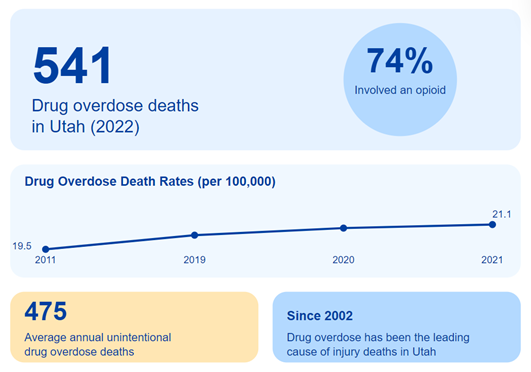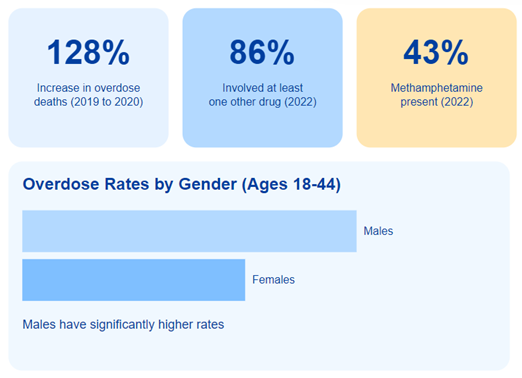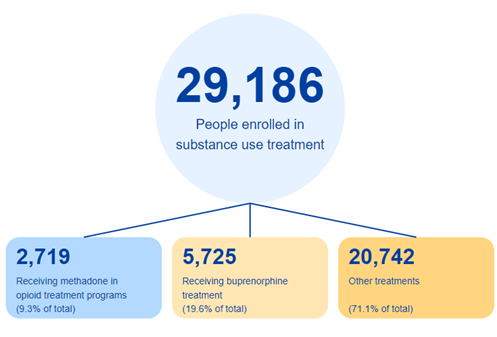Statistical Data on Drugs in Utah
Utah, like many states in the U.S., faces significant challenges related to substance abuse and drug overdoses. This report compiles key statistics on drug use, overdose deaths, treatment admissions, and related issues in Utah. The data presented here offers insights into the state’s ongoing efforts to combat the opioid epidemic and other substance abuse problems.
Drug Overdose Deaths

- In 2022, there were 541 drug overdose deaths in Utah, with 74% involving an opioid.
- Drug overdose has been the leading cause of injury deaths in Utah since 2002.
- The age-adjusted drug overdose death rate in Utah increased from 19.5 per 100,000 in 2011 to 21.1 per 100,000 in 2021.
- In 2020, the drug overdose death rate in Utah was 20.5 per 100,000.
- An average of 475 people die each year from unintentional drug overdose in Utah.
The data shows a concerning trend of increasing drug overdose deaths in Utah over the past decade, with opioids playing a significant role in these fatalities.
Drug Poisoning Deaths By Year in Utah:
| Year | Number of Deaths |
| 2018 | 264 |
| 2019 | 217 |
| 2020 | 190 |
| 2021 | 178 |
| 2022 | 166 |
While there’s been a general downward trend in drug poisoning deaths since 2018, the numbers remain concerning.
Opioid-Specific Statistics
- In 2022, there were 446 opioid overdose deaths in Utah, accounting for 67% of all drug overdose deaths.
- The age-adjusted death rate due to opioid overdose in Utah remained relatively stable, changing from 14.6 per 100,000 in 2011 to 14.1 per 100,000 in 2021.
- Annual opioid-related deaths in Utah:
| Drug Type | 2019 | 2020 | % Change |
| All Drugs | 495 | 531 | +7% |
| Prescription Opioids | 218 | 189 | -13% |
| Heroin | 145 | 143 | -1% |
| Fentanyl | 54 | 123 | +128% |
| Cocaine | 38 | 46 | +21% |
| Methamphetamine | 203 | 207 | +2% |
While the overall opioid death rate has remained relatively stable, the rise in synthetic opioid deaths, particularly fentanyl, is a growing concern.
Fentanyl-Related Statistics

- Fentanyl-involved overdose deaths increased by 128% from 2019 to 2020 and continued to rise.
- In 2022, 86% of fentanyl-involved overdoses involved at least one other drug.
- Methamphetamine was present in 43% of fentanyl-involved overdose cases in 2022.
- Males between the ages of 18-44 have significantly higher fentanyl-involved overdose death rates than females in the same age range.
The dramatic increase in fentanyl-related deaths, often in combination with other drugs, represents a critical public health challenge for Utah.
Youth Substance Use
2017-2019 Annual Averages
- 3.6% of youth aged 12-17 used marijuana in the past month.
- 5.1% of youth aged 12-17 used illicit drugs in the past month.
- 4.6% of youth aged 12-17 used alcohol for the first time in their lives.
- 3.3% of youth aged 12-17 used marijuana for the first time in their lives.
2021 Data
- Alcohol use among grades 9-12: 8.1%
- Marijuana use among grades 9-12: 7.8%
- Alcohol use among grades 8, 10, and 12 (SHARP data): 5.3%
- Marijuana use among grades 8, 10, and 12 (SHARP data): 5.9%
Substance Use Disorders
- Between 2017 and 2019, an average of 2.8% of Utah residents over age 12 had a past-year illicit drug use disorder.
- In the same period, an average of 3.8% had an alcohol use disorder.
While Utah’s substance use disorder rates are comparable to or lower than national averages, they still represent a significant portion of the population struggling with addiction.
Treatment Admissions (2020)

- 29,186 people were enrolled in substance use treatment.
- 2,719 were receiving methadone in opioid treatment programs.
- 5,725 were receiving buprenorphine.
Primary drug reported at treatment admission:
| Drug Type | 2017 | 2018 | 2019 | 2020 | 2021 Q1 |
| Prescription Pain Medicine | 8% | 6% | 3% | 3% | 5% |
| Heroin | 64% | 62% | 67% | 67% | 63% |
| Fentanyl | 0% | 0% | 0% | 1% | 3% |
| Crack/Cocaine | 27% | 16% | 15% | 13% | 11% |
| Methamphetamine / Speed | 65% | 71% | 73% | 76% | 75% |
| Cannabis/Marijuana | 21% | 21% | 20% | 25% | 34% |
| Alcohol | 16% | 13% | 12% | 14% | 15% |
| Benzodiazepines | 7% | 5% | 7% | 6% | 7% |
Methamphetamine and heroin remain the most commonly used drugs among new treatment clients, with a notable increase in marijuana use and emerging fentanyl use.
Economic Impact and Treatment Facilities
- Average individual total cost for residential drug rehabilitation treatment in Utah: $56,782
- In Utah, there are 322 active treatment facilities.
- 29,186 patients are serviced annually for drug rehab.
- 26,918 patients enroll in Utah’s drug rehab outpatient services annually.
- 1.99% or $45.97 million of the U.S. public’s total is spent on outpatient services in Utah.
- On average, an individual patient in outpatient rehab in Utah can expect to pay $1,708.
- 2,020 patients enroll in Utah’s drug residential (non-hospital) services.
- 2.21% or $114.7 million of the U.S. public’s total is spent on residential treatment in Utah.
- 248 patients are in Utah’s hospitals for drug rehab.
- 3 facilities in Utah offer free drug rehab treatment for all patients.
The high cost of residential treatment may present a significant barrier to accessing care for many Utah residents. The presence of some free treatment facilities is positive, but the small number suggests a potential gap in affordable treatment options. The substantial public spending on treatment services underscores the economic impact of substance use disorders.
Comparison with U.S. Rates

- Utah’s high school current alcohol use (8.1%) was lower than the U.S. rate (29.2%) in 2019
- Utah’s high school current marijuana use (7.8%) was lower than the U.S. rate (21.7%) in 2019
- Utah had the lowest reported rate of high school binge drinking (4.3%) among all 41 reporting states in 2019
Crime Lab Submissions (2020):
- Overall submissions decreased by approximately 30% compared to 2019
- Methamphetamine was the most common substance submitted
- 68% of methamphetamine submissions were in crystalline form
- 60% of fentanyl samples were in the form of counterfeit pills or tablets
- Only 13% of fentanyl samples had other drugs present
The decrease in crime lab submissions likely reflects reduced law enforcement activity due to the COVID-19 pandemic. The high prevalence of counterfeit fentanyl pills is concerning due to their potential lethality.
Opioid Prescribing and Overdose

- Opioid dispensing rate in Utah (2020): 48.4 per 100 people (down from 87 in 2006)
- In 2021, there were 446 opioid overdose deaths, accounting for 67% of all drug overdose deaths in the state.
- The age-adjusted death rate due to opioid overdose in Utah was 14.1 per 100,000 in 2021.
The substantial decrease in opioid prescribing rates indicates that efforts to address overprescribing have been effective. However, the high number of opioid overdose deaths suggests that illicit opioids, particularly fentanyl, have largely replaced prescription opioids as the primary concern.
Regional Variations in Youth Substance Use (2021):
- Highest rates of current alcohol use: Southeast (9.3%), Summit County (8.7%), and Weber-Morgan (8.7%)
- Lowest rates of current alcohol use: Utah County (3.0%) and Davis County (4.3%)
- Highest rates of current marijuana use: Southeast (11.3%), Weber-Morgan (8.2%), and Salt Lake County (7.3%)
- Lowest rates of current marijuana use: Central (4.0%) and Utah County (3.7%)
There are significant regional variations in youth substance use across Utah, which could inform targeted prevention efforts.
Statistical Data on Alcohol in Minnesota
Utah’s relationship with alcohol is complex, with statistics revealing both concerning trends and areas where the state performs better than national averages. This report compiles various alcohol-related statistics for Utah, focusing on binge drinking, heavy drinking, and their impacts on public health and the economy.
Binge Drinking Statistics
| Year | Utah (%) | U.S. (%) |
| 2011 | 12.0 | 18.3 |
| 2012 | 11.2 | 16.9 |
| 2013 | 12.3 | 16.8 |
| 2014 | 11.4 | 16.0 |
| 2015 | 11.6 | 16.3 |
| 2016 | 12.5 | 16.9 |
| 2017 | 11.5 | 17.4 |
| 2018 | 10.6 | 16.2 |
| 2019 | 11.2 | 16.7 |
| 2020 | 11.3 | 15.7 |
| 2021 | 11.7 | 15.4 |
| 2022 | 12.8 | 17.0 |
Utah consistently maintains lower binge drinking rates compared to the national average. In 2022, Utah’s binge drinking rate was 12.8%, while the national rate was 17.0%. This difference could be attributed to cultural and religious factors prevalent in Utah that influence attitudes toward alcohol consumption.
Binge Drinking by Age and Gender (2022)
- Males:
- 18-34: 20.5%
- 35-49: 19.4%
- 50-64: 13.8%
- 65+: 3.5%
- Females:
- 18-34: 14.8%
- 35-49: 11.6%
- 50-64: 5.8%
- 65+: 1.6%
Binge drinking rates are consistently higher among males across all age groups. The highest rates are observed in the 18-34 age group for both genders, with a significant decline in the 65+ age group.
Alcohol Use by Age Group in Utah (2017-2018 Annual Averages)
| Age Group | Estimate (thousands) | 95% Confidence Interval |
| 12+ | 694 | 636 – 756 |
| 12-17 | 16 | 11 – 22 |
| 18-25 | 127 | 110 – 146 |
| 26+ | 551 | 498 – 608 |
| 18+ | 679 | 620 – 739 |
The data shows that alcohol use is most prevalent among adults aged 26 and older, with this group accounting for the majority of alcohol users in Utah.
Heavy Drinking Statistics

- In 2022, 5.0% of Utah adults reported heavy drinking in the past 30 days, compared to 6.9% of U.S. adults.
- Heavy drinking rates in Utah have fluctuated between 3.3% and 5.0% from 2011 to 2022.
Utah’s heavy drinking rates are consistently lower than the national average, aligning with the trend observed in binge drinking statistics.
Youth Alcohol Use in Utah
- Past-month alcohol use among youth aged 12-17 (2017-2019): 4.3% (13,000 individuals)
- Past-month binge alcohol use among young adults aged 18-25 (2017-2019): 21.8% (88,000 individuals)
- Past-year alcohol use disorder among young adults aged 18-25 (2017-2019): 6.4% (26,000 individuals)
While youth alcohol use is lower than the national average, it still affects a significant number of young people in Utah, particularly in the 18-25 age group.
Alcohol Use Disorder (AUD) Statistics

- Past-year alcohol use disorder among people aged 12 or older in Utah (2017-2019): 3.8% (95,000 individuals)
- This rate is lower than both the regional average (6.9%) and the national average (5.3%)
Utah’s lower rate of alcohol use disorder compared to regional and national averages aligns with the state’s generally lower rates of alcohol consumption.
Alcohol-Related Deaths and Costs
- Annual alcohol-related deaths in Utah: 903
- Years of potential life lost annually due to excessive alcohol use: 26,746
- Cost of excessive alcohol use in Utah (2022): $2.209 billion (adjusted for inflation)
- Cost per drink in Utah (2022): $3.70
Despite lower drinking rates, alcohol use still has a significant impact on public health and the economy in Utah.
Binge Drinking by Local Health District (2022)
| Local Health District | Binge Drinking Rate (%) |
| Salt Lake County | 16.6 |
| Tooele | 17.6 |
| Summit | 14.5 |
| Weber-Morgan | 14.1 |
| TriCounty | 13.9 |
| Southeast | 12.6 |
| Davis County | 12.1 |
| Central | 11.4 |
| Wasatch | 11.2 |
| Utah County | 8.3 |
| Bear River | 8.1 |
| Southwest | 7.8 |
Areas with low rates:
- Provo/BYU, Provo (East City Center), Orem (East): Data not available or very low rates
There’s significant variation in binge drinking rates across Utah’s health districts, with Tooele and Salt Lake County showing the highest rates, while Southwest and Bear River have the lowest rates among reported data.
Binge Drinking by Race (2022)
- Native Hawaiian, Pacific Islander: 18.1%
- Asian: 16.3%
- Black, African American: 16.1%
- American Indian/Alaska Native: 15.6%
- White: 12.4%
- Hispanic/Latino: 5.6% (95% CI: 4.1% – 7.7%)
- Non-Hispanic/Latino: 4.9% (95% CI: 4.3% – 5.7%)
Binge drinking rates vary across racial groups in Utah, with Native Hawaiian and Pacific Islander populations showing the highest rates, while White populations have the lowest rates among the reported data.
Alcohol-Related Emergency Department Visits (2019)
- Emergency department visits due to alcohol poisoning: 398
- Non-fatal motor vehicle crashes related to alcohol: 786
These statistics highlight the immediate health and safety risks associated with excessive alcohol use in Utah.
This comprehensive overview of alcohol use statistics in Utah reveals a complex picture. While the state generally has lower rates of binge and heavy drinking compared to national averages, alcohol use still poses significant public health and economic challenges. The data suggests a need for continued efforts in alcohol abuse prevention and treatment, particularly among high-risk groups and regions.
Sources
- Average Cost of Drug Rehab [2023]: by Type, State & More
- Health Indicator Report of Drug Overdose and Poisoning Incidents
- Behavioral Health Barometer
- Substance Abuse Statistics for Utah – Cirque Lodge
- IBIS-PH – Complete Health Indicator Report – Substance Abuse (Alcohol or Marijuana) – Adolescents
- Mental Health and Substance Use State Fact Sheets: Utah | KFF
- Utah Drug Monitoring Initiative: Annual Report
- Alcohol Abuse Statistics [2023]: National + State Data – NCDAS
- 2017-2018 National Surveys on Drug Use and Health: Model-Based Estimated Totals (in Thousands) (50 States and the District of Columbia
- IBIS-PH – Complete Health Indicator Report – Alcohol Consumption – Heavy Drinking
- IBIS-PH – Health Indicator Report – Alcohol Consumption – Binge Drinking